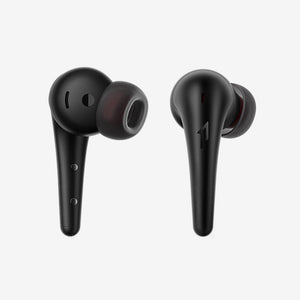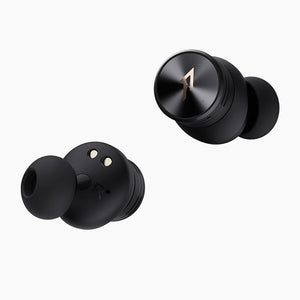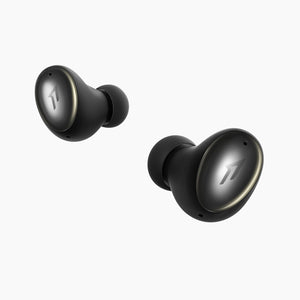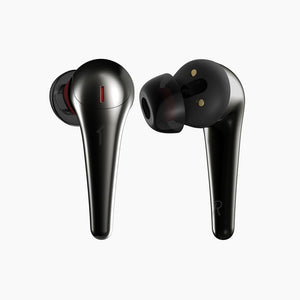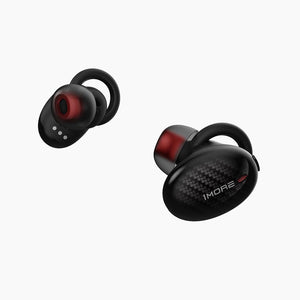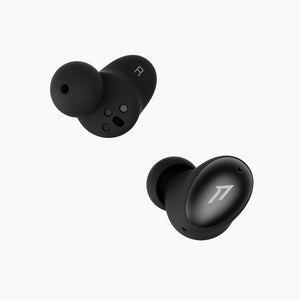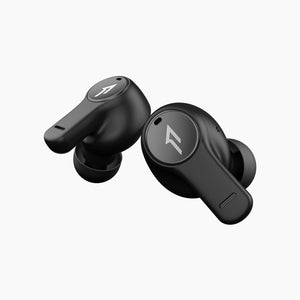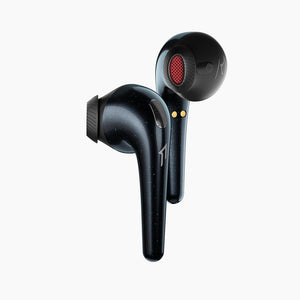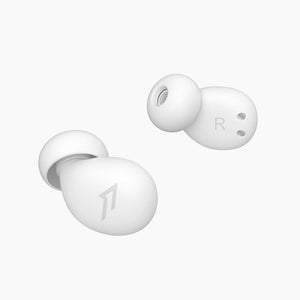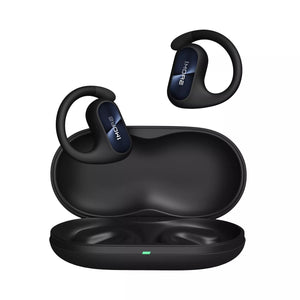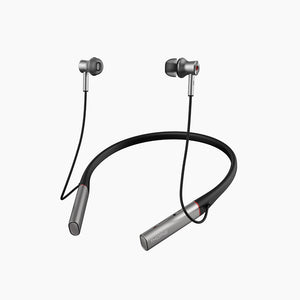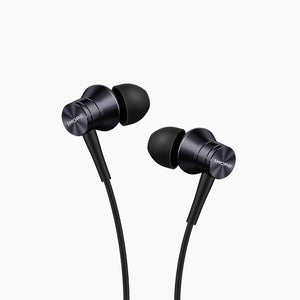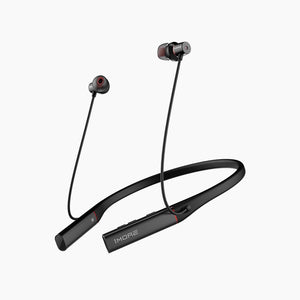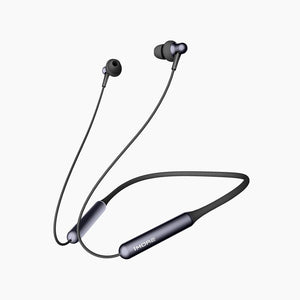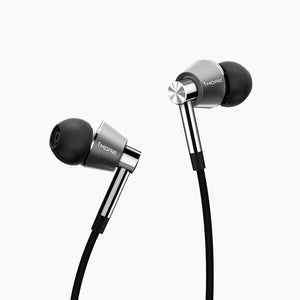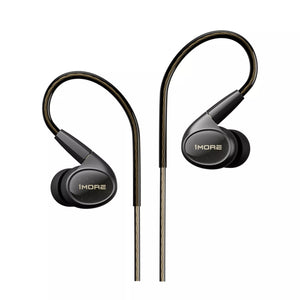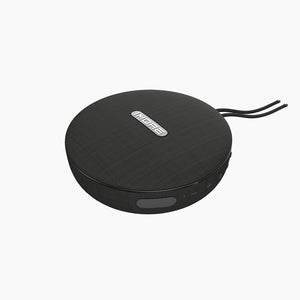NEW TO 1MORE?
Create an account to track, change or return your order with ease.
Your shopping bag is empty
Eddie Ciletti- Manhattan Sound Engineer Compares our Triple Drivers
By: Eddie Ciletti - HiFi Zine, the Audio Enthusiast Webzine
Not counting the Bluetooth earpiece I once briefly tried with my phone, my longest in-ear experience until a few months ago had lasted about 30 seconds. Nonetheless, I buy earbuds several times a year for my teenage boys, who seem to eat them as an after-school snack. Not hearing a whisper of what they are listening to is a good sign they are self-policing and protecting their hearing. Other than that, I try to not impose my audio OCD on them. Discerning ears are developed over time. (By contrast, I often hear what other people are listening to at the gym.)
Everything changed when 1More, based in San Diego, sent me a pair of their in-ear E1001 triple-driver in-ear headphones (which I will also refer to as “earphones” in this review). I immediately loved them – they are sonically pleasant and comfortable to wear. 1More’s goal with these ‘phones was to improve the sonic performance to reduce ear fatigue and hearing loss. More than just the obvious quality in design and construction, 1More enlisted the ears of Grammy winning sound engineer Luca Bignardi, which I can say made a difference. As a recording engineer with Italian heritage, I think Luca’s ears were a good choice!
But this is more than just a review of a single pair of earphones – 1More also sent seven of their competitors’ products along for comparison, which was unusual, but enlightening.

Fit and finish
The overall design of the E1001 triple driver in-ear earphones is both aesthetically appealing and robust. The body is made of a nicely finished, lightweight but strong aluminum alloy. I also like the feel of the woven fabric cable. It has been very robust so far, considering the month of use and the number of times I have plugged and unplugged them for use, testing and sharing with my family.

Before attempting to fairly assess sonic quality, the first task is to sort through the ear tip options. To get the most bass response and smoothest, more damped treble response requires an airtight seal. 1More made ear tip optimization easy (see image below), which is essential to achieving extended bass response and smooth treble region. (Ear buds are not known for having much – if any – bass response, and a thin ‘zingy’ top that does not make music the multi-dimensional experience that it should be.) From their product literature, “The Triple Drivers are ergonomically designed with oblique angles that match your ear canals. This makes them more comfortable to wear and less likely to fall out, leaving you free to enjoy your music.” In contrast, the competitor’s ear-tip options were not so well ‘organized’ – as in, came loosely in a bag.

At left, 1More’s triple driver has the largest opening of all the in-ear ‘phones tested – nearly 0.23 inches, or 5.8mm. Combine this with a silicone ear tip that is remarkably delicate, yet robust, allowing the least obstructed path from the driver to your ear canal.

Ear tip size is the most important – and often overlooked – aspect of earphone performance. The image to the left shows how 1More organized – from top to bottom – five silicone ear tips ranging in size from 14.5mm to 10 mm. Below them are three memory foam ear tips ranging from 14.5mm to 11mm.
Better coupling between the driver and the ear improves bass response and dampens high frequency resonance. Improved sonic performance is likely to encourage longer listening times and cause less ear fatigue. In short, the 1More in-ears have the best bottom and smoothest top.
Sensitivity and impedance
There are several factors to consider when comparing earphones. The ‘louder,’ or more sensitive models are not necessarily more efficient, they could simply have a lower impedance that turns a given voltage from the headphone amplifier into more acoustic output. For example, using the 1More triple-drivers as reference (32Ω), the Grado single driver (24Ω) was louder for the same volume control setting. Grado’s reference is 1mW, which, according to my calculations is 155mV applied to 24Ω. More voltage would have to be applied to the 1More buds (179mV) for them to dissipate 1mW.
(For whatever reason, headphone/earphone impedance is not standardized. Impedance is one of the many factors that contribute to sensitivity – the SPL or Sound Pressure Level for a given volume setting. Neodymium magnets have a higher magnetic field plus lower mass and size for a given flux density relative to conventional AlNiCo and ceramic magnets. They’re also used in all modern microphones, loudspeakers, electric car motors and generators.)
Built-in mic and remote
The 1More has a 4-conductor 3.5mm TRRS plug to accommodate a microphone and remote control. I used it with my phone and the microphone worked very well. Table 1 below includes mic and remote details. If the remote control is important to you, be sure to check compatibility with your device (i.e. iOS, Android, Windows).
About the recording and mixing process
Before moving on to the listening comparison, it might be helpful to know how professionals hone their craft. This is my playground…
Recording engineers and editors often use headphones when they need to hear every detail as well as every flaw. The biggest challenge for mix engineers is that loudspeakers acoustically interact with the space around them. Of the key factors to correct for this, control rooms are physically proportioned and acoustically treated to remove anomalies such as treble reflections and low frequency standing waves. Main and alternate speaker systems are symmetrically placed within that environment. Engineers spend most of their time centered between them, in the ‘sweet spot,’ which is as acoustically close to the headphone environment as possible.
The goal is for mixes to play well on all systems – to be impressively hi–fi on a great system, while not becoming muddy in the van or screechy on laptop and media players. This game of “successive approximation” is one that professionals play, tweaking the mix until nothing critical gets lost in translation.
By contrast, consumers listen in such a variety of ways and often don’t sit down, as engineers do, between their speakers. On the plus side – for this review in particular – headphones have the potential to provide an experience that is closer to what the artist and engineers intended.
Listening comparison
All comparisons were done using the iFi micro DAC / headphone amplifier. Each earphone was tested at least five times. The first try was just to optimize the ear tips. This was not easy for me and at first I chalked up my struggle to achieve a good physical seal to a combination of my idiosyncratic ears and lack of thorough testing on the manufacturing side. Each ear is physically unique, which is why professionals have custom-made ear tips. That said, a smidgen of hand crème on the ear tips greatly improves the positioning process.
Each experience built on the other so that familiarity allowed me to more quickly get better sound for the final, more thorough comparison. Judgement was purely subjective, using a wide range of familiar material, with the emphasis on sonics, ease of insertion, comfort and quality of seal for noise isolation and optimum sound transfer.
Table 1 below lists the various earphones in order of preference, with the most preferred at the top. Of the three most important features, ease and quality of both fit and the ability to achieve a good seal, are of primary importance in order to deliver best sonic performance. I judged the earphones based on their ability to reproduce the lowest bass notes and kick drum resonance. Equally important was a smooth upper midrange presence and a delicate, “airy” treble. The 1More E1001 is my favorite, the Grado iGe came in second and the Sennheiser M2 IEi came in third.
Note that not until collecting prices and specs for Table 1 did I have any idea of the street price of any of them.

Table 1. In-ear headphone comparison in top / down preference order. Note that the 1More E1001 was the outstanding sonic winner compared to much more expensive models. Specifications are as provided by the manufacturer.
Additional listening notes:
- 1More E1001: Remarkably extended bottom and silky smooth top. The lightweight cloth cable is less tangle-prone. Large opening, best silicone ear tip design (doesn’t block sound when positioning). These are sonically superior to all of the other earphones in this comparison, and therefore the reference.
- Grado iGe: More sensitive due to the 24Ω impedance. Similar bass to the E1001, smooth top, a little darker than E1001
- Sennheiser M2 Iei: Good bass (like above), the treble is a tad too present / sibilant, pushing cymbals forward. Great case insert allows cable to be neatly wound for easy, tangle-free retrieval.
- Shure SE535: Stiff cable. The over-ear wire is either ineffective (and wouldn’t be necessary if cable was lighter) or requires professional fitting assistance. Sound disappears when optimizing position, because the opening is very small and ear tips can easily block the opening. While this is Shure’s spendy model – it has only slightly more bass than their more affordable SE215 and less bass overall than any of the top three products.
- Shure SE215: The over-ear wire is either ineffective (and wouldn’t be necessary if cable was lighter) or requires professional fitting assistance. Sound disappears when optimizing position, because the opening is very small and ear tips can easily block the opening. Slightly more bass than Etymotic hf5 (below). Stiff cable.
- AudioFly AF160: Less bass, more mid and louder than E1001, the latter due to lower impedance. The lightweight cloth cable is less tangle-prone.
- Westone W30: OK, but a little mid honky.
- Etymotic hf5: Very little bass, top end OK.
Note: Poor fit makes it very difficult to achieve a good sound rating. Yes, it’s possible to manually hold the drivers in place to prove that ‘good sound’ can be delivered. Lack of good fit is part design flaw and part “luck of the draw,” because human ears are subject to wide variations. That said, a smidgen of hand crème on the ear tips really helps!!
Concluding remarks
As shown in Table 1, for my ears and tastes, the 1More E1001 triple driver earphones clearly outperformed more expensive examples. For my ears, they excelled in their quality of fit and the ability to achieve a good seal, of primary importance to deliver best sonic performance. The 1More’s were a completely different experience to many other earphones – in fact, I was blown away by the extended bass response and smooth treble region.
1More’s packaging was also outstanding – they are obviously very proud of their achievement, and should be. The E1001 has a compact travel case for safe storage. Alas, my son and I are using both the in-ear headphones and one of the 1More over-ear headphones (follow-up coming in a future article) daily, so they rarely see their cases.

About the author
Eddie Ciletti is a life-long audio engineer and technician. He tries to find the balance between the art and the science of sound. He’s on Facebook and his web site is at: www.tangible-technology.com.
A music producer’s review of 1MORE’S Triple Driver In-Ear Headphones
Review: 1MORE Triple Driver In-Ear Headphone with In-line Microphone and Remote
If you think the article is helpful, we suggest you could choose to share it via
Trending Posts
1MORE EVO - True-to-Life Sound That Rivals Wired Audiophile Headphones
Jul 12, 2022
A New Firmware Update with EQ Feature for 1MORE EVO
Jul 08, 2022
The Best Headphone Gifts for Christmas 2021
Nov 25, 2021
1MORE ComfoBuds 2 Bring an Unmatched Ultra Comfortable EarBuds
Oct 13, 2021
1MORE ColorBuds 2 Bring New Meaning to Color Your Sound
Sep 22, 2021
1MORE ComfoBuds Pro Sets A High Bar For True Wireless ANC Earbuds
Sep 15, 2021
1MORE Launched ComfoBuds Z to Bring Better Sleep
Sep 09, 2021
1MORE launches ComfoBuds
Jan 14, 2021
1MORE Receives 3 CES Innovation Awards
Jan 14, 2021
1MORE Launches New Affordable True Wireless Headphones
Nov 10, 2020
Tag






